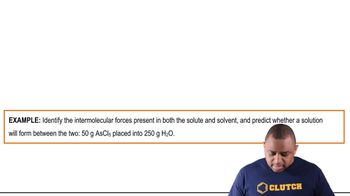The Ogallala aquifer described in the Closer Look box in Section 18.3, provides 82% of the drinking water for the people who live in the region, although more than 75% of the water that is pumped from it is for irrigation. Irrigation withdrawals are approximately 18 billion gallons per day. (a) Assuming that 2% of the rainfall that falls on an area of 600,000 km2 recharges the aquifer, what average annual rainfall would be required to replace the water removed for irrigation?
Ch.18 - Chemistry of the Environment
Chapter 18, Problem 44b
The Ogallala aquifer described in the Closer Look box in Section 18.3, provides 82% of the drinking water for the people who live in the region, although more than 75% of the water that is pumped from it is for irrigation. Irrigation withdrawals are approximately 18 billion gallons per day. (b) What process or processes accounts for the presence of arsenic in well water?
 Verified step by step guidance
Verified step by step guidance1
insert step 1: Understand that arsenic can naturally occur in groundwater due to the dissolution of minerals from the Earth's crust.
insert step 2: Recognize that arsenic can also be introduced into groundwater through human activities such as mining, industrial processes, and the use of arsenic-containing pesticides.
insert step 3: Consider the geological composition of the region where the Ogallala aquifer is located, as certain rock types may contain arsenic-bearing minerals.
insert step 4: Identify that the process of water percolating through arsenic-rich rocks and soil can lead to the leaching of arsenic into the groundwater.
insert step 5: Note that changes in the chemical environment, such as pH and redox conditions, can affect the mobility and concentration of arsenic in groundwater.

Verified video answer for a similar problem:
This video solution was recommended by our tutors as helpful for the problem above.
Video duration:
42sWas this helpful?
Key Concepts
Here are the essential concepts you must grasp in order to answer the question correctly.
Arsenic Sources
Arsenic is a naturally occurring element found in the Earth's crust, often present in groundwater due to geological formations. It can leach into well water from minerals and ores, particularly in areas with high natural arsenic levels. Human activities, such as mining and the use of certain pesticides, can also contribute to arsenic contamination in water supplies.
Recommended video:
Guided course

Intermolecular Forces Example
Groundwater Contamination
Groundwater contamination occurs when pollutants infiltrate the water table, affecting the quality of water in aquifers. This can happen through various pathways, including agricultural runoff, industrial discharges, and improper waste disposal. Understanding the mechanisms of contamination is crucial for assessing water safety and implementing remediation strategies.
Recommended video:
Guided course

Change in Pressure Units Example
Irrigation Practices
Irrigation practices can influence the concentration of contaminants like arsenic in groundwater. Excessive irrigation can lead to the leaching of arsenic from soil and rocks into the water supply, especially in regions where arsenic is naturally present. Additionally, the use of contaminated water for irrigation can further exacerbate the issue, highlighting the need for sustainable water management.
Recommended video:
Guided course

Scientific Notation to Standard Notation
Related Practice
Textbook Question
2
views
Textbook Question
The organic anion
is found in most detergents. Assume that the anion under-goes aerobic decomposition in the following manner: C18H29SO3- + 51 O2 → 36 CO2(aq) + 28 H2O (l) + 2 H+(aq) + 2 SO42-(aq) What is the total mass of O2 required to biodegrade 10.0 g of this substance?
